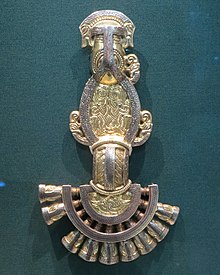
Back Фібула Byelorussian Фібула BE-X-OLD Фибула Bulgarian Fibula (broš) BS Fíbula Catalan Spona (archeologie) Czech Fibula (spænde) Danish Fibel (Schließe) German Fibolo Esperanto Fíbula Spanish
This article needs additional citations for verification. (November 2009) |




A fibula (/ˈfɪbjʊlə/, pl.: fibulae /ˈfɪbjʊli/) is a brooch or pin for fastening garments, typically at the right shoulder.[3] The fibula developed in a variety of shapes, but all were based on the safety-pin principle. Unlike most modern brooches, fibulae were not only decorative; they originally served a practical function: to fasten clothing for both sexes, such as dresses and cloaks.
In English, "fibula" is not a word used for modern jewellery, but by archaeologists, who also use "brooch", especially for types other than the ancient "safety pin" types, and for types from the British Isles. For Continental archaeologists, all metal jewellery clothes-fasteners are usually "fibulae".
There are hundreds of different types of fibulae. They are usually divided into families that are based upon historical periods, geography, and/or cultures. Fibulae are also divided into classes that are based upon their general forms. Fibulae replaced straight pins that were used to fasten clothing in the Neolithic period and the Bronze Age. In turn, fibulae were replaced as clothing fasteners by buttons in the Middle Ages. Their descendant, the modern safety pin, remains in use today.
In ancient Rome and other places where Latin was used, the same word denoted both a brooch and the fibula bone because a popular form for brooches and the shape of the bone were thought to resemble one another. Some fibulae were also sometimes used as votive gifts for gods.[3]
Lost fibulae, usually fragments, are frequently dug up by amateur coin and relic hunters using metal detectors.

- ^ "Pair of Eagle Fibula". The Walters Art Museum. Archived from the original on 2013-11-03. Retrieved 2012-09-18.
- ^ British Museum Collection
- ^ a b "fibula". fashionhistory. Retrieved 2019-03-30.
© MMXXIII Rich X Search. We shall prevail. All rights reserved. Rich X Search